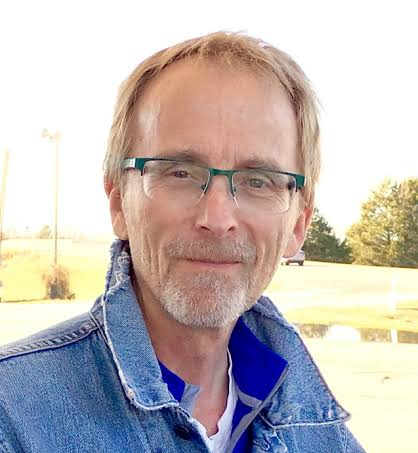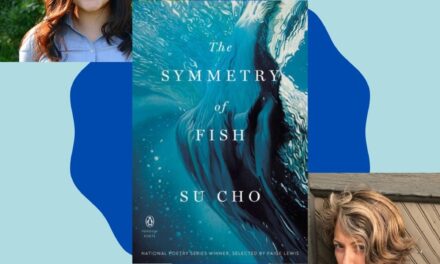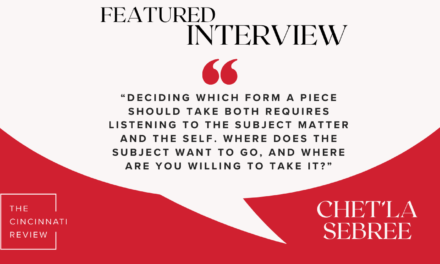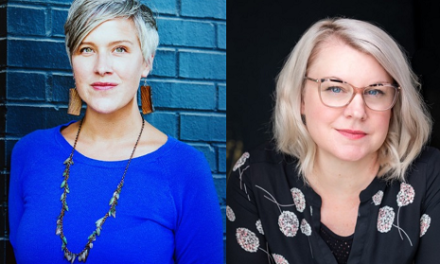Associate Editor Connor Yeck: Today we feature the second half of back-to-back conversations between CR contributors Dennis Hinrichsen and Andrew Collard, who have new poetry collections coming out this March. Be sure to check out part one in which Andrew discusses his debut collection Sprawl, and keep reading to hear Dennis’s insights (and tracklisting!) for his tenth book, Flesh-plastique! We can’t wait to check out these collections in full and are ecstatic to have gotten the chance to feature some of their poems in CR‘s pages.

Andrew Collard: There’s so much to talk about in terms of the intrinsic connection between content and form with Flesh-plastique, but I wanted to ask specifically about the collaged, almost found-footage aesthetic of the book’s opening poem “[This is the Nuclear Age],” which mines your experiences living in Boston in the 1980’s. How did those experiences inform what feels to me like a very present-tense book?
Dennis Hinrichsen: It’s interesting you zeroed in on this poem—it was the first I drafted when I began the book, and the last one finished for some reason. My previous book, schema geometrica, was built from broken sonnets whose collage models came from those wonderful boxes of Joseph Cornell and the films of Sergei Parajanov, The Colour of Pomegranates in particular, where he used highly stylized tableau scenes to carry the narrative. This was just another box shape from my point of view. So when I began Flesh-plastique, which I imagined as a sister book to schema, I wanted to enlarge the frame and write much longer collages that still moved through what I imagined were Euclidian congruities but had a larger footprint and perhaps less clearly defined edges.
My work as technical writer in the Boston area for an engineering firm that built, among other things, nuclear power plants was central to the vision in the book. At one point during my time there—this was post-Three Mile Island and pre-Chernobyl—I was assigned the task of saving the nuclear industry with two other liberal arts majors and a stack of legal pads and a jar of Bic pens. It was hopeless, we knew it was hopeless, but we tried for a year to make arguments that examined the entire life cycle of a nuclear plant—from the mining of uranium to the design and licensing to the building to the operation and the environmental impacts to the decommissioning and handling of waste—all this compared to a like analysis of a coal-fired plant. So that logos is pretty much the vision of this book as well as the previous, with Flesh-plastique more focused on the waste associated with living in the developed world and consuming light and clothes and water and throwing it all away. All is this unfolding present tense.
AC: This calls to mind that line from Philip Levine’s “The Present,” where he writes that he began the poem in the present tense “because nothing is past.” The deliberately fragmented nature of the opening poem foreshadows the formal cues of several of the book’s longer poems, but also the structure of the book itself, culminating in the two “debris field” sections. What drew you to this idea of debris as mosaic?

DH: I like that Levine quote—the present is all we have, with electricity and water and air running through it—a magnificent network of connections we are all part of through our patterns of consumption and being consumed. Of throwing stuff away. I just wanted to map my place in all that. In that debris field. In fact, that was the working title of the book when it began. My daughter and her wife had recently moved from a liquefaction zone in the Bay Area to inside the exclusion zone of a nuclear power plant in Michigan, so that played into the idea. So too the “unswept floor” mosaic from ancient Rome that speaks to the Romans’ dining habits of tossing scraps to the floor. The scraps are depicted in the tiles—as memento mori maybe—food for the dead—as some commentary on the theater of consumption. When I walk the streets of my city, I think I walk that unswept floor. A world of waste. Of things thrown away in the grand eros of our living. That’s really the root note of the first poem and ends up being mapped throughout the rest of the book through the two debris field sections, some of them even titled with “[mosaic]” to reinforce that motif.
AC: I’m glad you brought up schema geometrica earlier, too, which is a book I’m still in awe of and which, as you suggested, connects directly with Flesh-plastique, especially those “debris field” sections—the sonnet-like formal gesture is still there, and also the voice, which I’m going to take this occasion to describe as “holodeck Whitman.” The “becquerels,” though, that make up the book’s second section are something else entirely, and unique both within your body of work and outside of it, to my mind. What was the genesis point for these shorter, more ambient constructions?
DH: “Holodeck Whitman”—I love it! And so on point. In schema I was just trying to close that metaphysical gap between self and other, whether it was human or electronic waste, whether it was in my analog space or the digital world I fell into through my iPhone. I was also trying to sound very different and think very differently in a poem—so all my “voices” are there: awe and wonder, intense anger, joy, love, irreverence, etc. And then I wanted to map it all in broken sonnets with Shakespeare and James Brown as my guides, that is, with a really pronounced dynamics. It allowed me to cut a lot of world into these private spaces. So in Flesh-plastique, conceived as a sister book, I wanted to extend that collage logos into rangier poems with a darker tone to them. Again, I wanted to sound and think differently.
The idea of essences or atmospheres that came from two initial sources—the digital work of Giacomo Costa—his atmosfera—and Atmosphere Conditions (Green Integer, 1999) by Ed Roberson. I wanted to capture those moments that flash right before you fall asleep, before narrative and scene take over. Once I started, the real catalyst was the work of Aimé Césaire—I was really taken by the poems and used lines of his as epigraphs that I initially placed at the bottom of the page and called fulcrums on which the poems—centered on the page—balanced. Love the surrealistic feel of them still moored to the fractures that caused them. They ended up being vestigial tails as I edited. In the main, I was trying to map that nether world during the early days of the pandemic when gunshots and motorcycles racing long into the summer nights were the constant ambient. And then I stumbled on “becquerels”—such a beautiful word—so much better than calling this run of poems “roentgens.” And then a quick shout out to Christopher Nelson at Green Linden Press for going with white lettering on black pages to enhance the effect.
AC: It seems like Green Linden Press has really gone all out in getting your vision for these poems to the page, whether we’re talking about the becquerels, or the zoetropes in Flesh-plastique’s first section, or schema’s overlaid erasure pages and visuals. That’s to say, too, these books look a lot different as objects than, for instance, 2000’s Detail from the Garden of Earthly Delights (Univerity of Akron Press), a seminal book in your oeuvre that experiments in its own directions. Over the course of ten books of poems, has your idea of what constitutes a book-length project changed?
DH: My first two books were organic gestures—the poems written by smoke and mirror—I really didn’t know what I was doing, so I imitated my heroes (James Wright, Levine, Kinnell, Hugo primarily) and held to a flimsy zen vibe that they would hang together because I’d written them. It wasn’t until my third book, Detail from the Garden of Earthly Delights, that I understood something about form and free verse and could get that on the page. New Formalism was the rage during this time, but returning to traditional forms wasn’t the answer for me. So I spent a long time seeking out ideas that helped me shape a kind of free-verse prosody and clung to the work of Charles Wright like a shipwrecked sailor. I ended up working off a Robert Hass essay from Twentieth Century Pleasures (Ecco reprint, 2000), an essay by Steven Dobyns on ghost form, something Marvin Bell said about the triplet, Hass’s translations of Issa, Buson, and Bashō, and Charles Wright’s lowrider. I was still chasing content, but I had a formal tool. About the time of my sixth book, I started chasing form rather than content—primarily the Shakespearean sonnet—which I played with in long poems in 7-line half sonnet patterns—or in poems where I stacked sonnets. I was also experimenting with punctuation here, with integrating more cinematic effects into the poems—more dynamics. I was really trying to teach myself how to write a short poem. The breakthrough was a poem from This Is Where I Live I Have Nowhere Else To Go, “[Box of Light w/Keats in It] [& an iPhone] [& a Boy],” where I took a five-page poem and reduced it to a broken sonnet. That poem basically unlocked schema geometrica. I had a shape that called out to content in a kind of John Cage fashion. Every day I’d wake and check the news feed and start, slowly more and more embodying Frost’s element of surprise. It was exhilarating. That same energy has been carried over into Flesh-plastique. And then I’ve had the amazing good fortune to be with Green Linden Press and Christopher Nelson, who embraces experimentation and has been so supportive in pushing what a book of poetry can be with the overlays, the black pages, QR codes with each that take the reader to experimental soundscapes put together by composer/musician friends of mine. I hope to continue that formal experimentation with the next book.

Flesh-plastique Playlist:
Disc 1. Fission
1. “Oh Yeah” by Can (begins with the sound of a nuclear explosion)
2. “Dirty Water” by The Standells
3. “Rift” by Helen Money
4. “Heart Full of Soul” by The Yardbirds
5. “In the Pines” by The Louvin Brothers
6. “A Taste of Honey“ by Herb Alpert and the Tijuana Brass
7. “No Reply” by The Beatles
8. “Not Fade Away” by Buddy Holly
9. “Werewolves of London” by Warren Zevon
10. “Fire and Brimstone” by Link Wray
Disc 2. Fusion
1. “I Had Too Much to Dream Last Night” by The Electric Prunes
2. “She Said Yeah” by The Rolling Stones
3. “Here Comes My Baby” by the Tremeloes
4. “I Got the Feelin’” by James Brown
5. “Nothing To Show For It” by Femi Kuti
6. “Archangels Thunderbird” by Amon Düül II
7. “Get Up, Stand Up (live)” by Toots & The Maytals
8. “I Want You Back” by The Zombies
9. “Kozmik” by Ziggy Marley and The Melody Makers
10. “Everybody Cryin’ Mercy” by Mose Allison
Flesh-plastique is Dennis Hinrichsen’s tenth book of poetry. His previous books include schema geometrica (Wishing Jewel Poetry Prize; Green Linden Press, 2021) and This Is Where I Live I Have Nowhere Else To Go (Grid Poetry Prize; 2020). His other awards and prizes include a Best of the Net selection and the Third Coast Poetry Prize, as well as the Akron, FIELD, Tampa, and Michael Waters Poetry Prizes. He has new work appearing or forthcoming in diode, The Glacier, The Pedestal, and Timber. He lives in Lansing, Michigan, where he does freelance workshops.
Andrew Collard is the author of Sprawl (Ohio University Press, 2023), winner of the Hollis Summers Poetry Prize. His poems have appeared in Ploughshares, AGNI, Best New Poets, and elsewhere. He currently lives in Grand Rapids, Michigan, with his son, where he teaches writing at Grand Valley State University.










